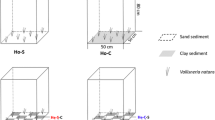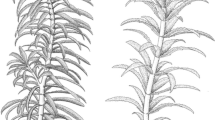Abstract
The isopod Sphaeroma terebrans, which bores into the prop roots of the red mangrove, Rhizophora mangle, can cause death and subsequent breakage of the inhabited root and, debatably, may reduce the support system of the tree. We examined whether different characteristics of a root or its physical setting, both of which may relate to habitat quality, influence the colonization of S. terebrans. A series of in situ experimental manipulations were conducted over 2 years. The first experimental protocol examined colonization of intact root substratum. Free-hanging aerial prop roots which were previously unsubmerged were bent down and anchored underwater at high tide after which the colonization of S. terebrans was monitored. A second manipulation was performed to evaluate the relative roles of submergence depth and plant anatomy in isopod colonization preference. Detached aerial prop roots were oriented either with the root tip directed downward, or upside down with the root tip directed upward but at a constant water depth. Additionally, detached aerial prop roots were oriented so that their tips were in contact with the sediment surface in order to investigate whether colonization on grounded roots was prevented by benthic predators. For all experiments, colonization began within 24 h; juveniles were the predominant colonizers. The submergence depth of a prop root, a characteristic of a root's physical setting, was consistently the strongest component correlated with the abundance of colonizing S. terebrans. The root-quality feature of root diameter was also found to play a significant role in colonization. Biotic influences, such as predation, however, did not influence recruitment of the isopod onto a root. Additionally, the absence of burrowing on grounded roots appeared to be related to intrinsic plant features. Along a root there was a strong preference by S. terebrans to colonize the root tip region (i.e., youngest part of the root) especially when these roots were also the deepest. The results of our experimental manipulation using natural root substratum are the first to identify physical setting as an important feature of habitat suitability for S. terebrans.
Similar content being viewed by others
Author information
Authors and Affiliations
Additional information
Electronic Publication
Rights and permissions
About this article
Cite this article
Brooks, A.R., Bell, S.S. Colonization of a dynamic substrate: factors influencing recruitment of the wood-boring isopod, Sphaeroma terebrans, onto red mangrove (Rhizophora mangle) prop roots.. Oecologia 127, 522–532 (2001). https://doi.org/10.1007/s004420000619
Received:
Accepted:
Published:
Issue Date:
DOI: https://doi.org/10.1007/s004420000619




